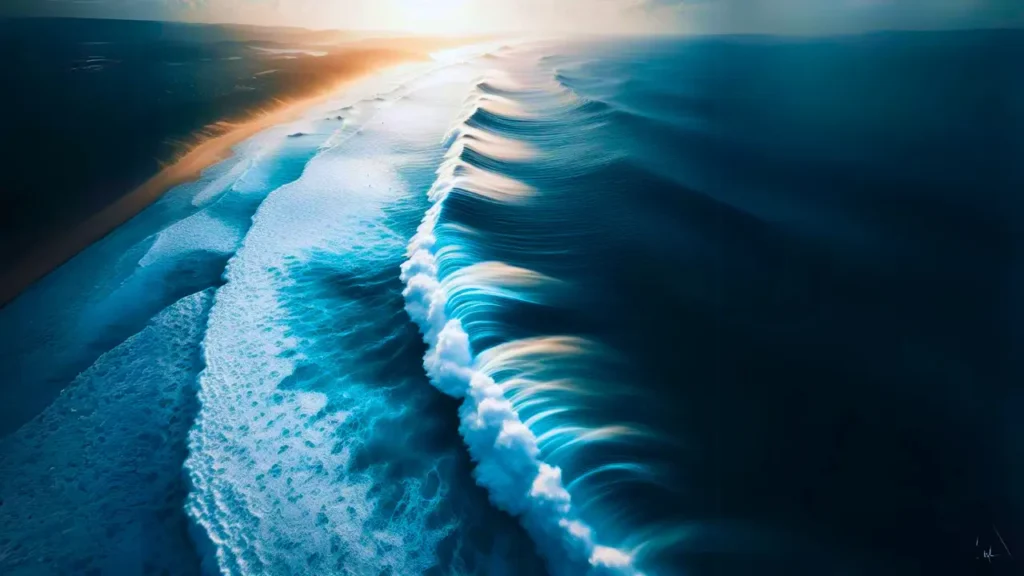
A fascinating spectacle unfolds across the vast expanses of the world’s oceans, where waves of varying sizes and strengths traverse great distances, from gentle ripples to towering walls up to 30 meters. The driving force behind these oceanic undulations lies primarily in the influence of winds, capable of propelling waves across thousands of kilometers when allowed to flow uninhibited.
Wind: The Instigator of Ocean Waves
Waves come to life when the force of the wind engages with the surface water, transferring its energy and setting the water into a circular motion. Water molecules’ rhythmic rise and fall generate a wave that progresses toward the prevailing wind. It’s crucial to understand that waves are energy carriers, not water. A fitting analogy is a crowd executing a Mexican wave in a stadium, where individuals remain stationary while the created wave circulates the arena.
Interaction with the Shore: Deceleration and Breaking
As waves approach the shore, they encounter the shallower ocean floor. This encounter causes the base of the wave to slow down, influencing the deeper segments. The resulting deceleration prompts the wave to elevate, pitch forward, and ultimately break. This breaking phenomenon is a common occurrence along coastlines worldwide.
Factors Influencing Wave Magnitude
The magnitude of a wave depends on various factors, including wind intensity, the duration of its force, and its fetch—the distance it traverses over the water. Oceanographers quantify wave height using “significant wave height,” which denotes the average height of the most significant 33 percent of waves in a given oceanic region at a specific time.
For example, if the wind blows at 55.6 kilometers per hour for an hour across a 1000-kilometer-wide water stretch, it would generate waves with a significant wave height of 0.7 meters. If this wind persists for 48 hours, the wave’s crest could surge to an impressive 10.5 meters, approximately twice the height of a double-decker bus.
Rogue Waves: Unveiling the Surprising Commonality
Occasionally, waves combine to form a single wave significantly higher than their counterparts. Once considered rare or even fictional, enhanced sea monitoring recognizes these rogue waves as surprisingly common. A deeper understanding of the intricate forces behind their occurrence raises the prospect of predicting rogue waves in the future.
Climate Change and Other Wave Causes
While wind remains the primary driver of ocean waves, other phenomena can also contribute. Seismic events, such as underwater earthquakes, can give rise to long-wavelength waves known as tsunamis, resulting from the substantial displacement of water. Additionally, the gravitational forces exerted by the sun and moon contribute to wave formation, giving rise to the ebb and flow of tides.
Certain studies suggest a heightened likelihood of extreme waves due to climate change, attributed to increased storm frequency and polar ice melting. As our understanding of these complex dynamics deepens, so does our ability to anticipate and respond to the various forces shaping ocean waves’ mesmerizing and dynamic world.
READ MORE: Why do flamingos stand on one leg?
What are the three leading causes of waves?
The three leading causes of waves are wind, seismic events, and gravitational forces exerted by celestial bodies like the sun and moon.
How does the moon cause waves?
The moon causes waves through gravitational forces that create the phenomenon of tides. The moon’s gravitational pull influences the water, creating a rise and fall known as tidal movements.
What is the difference between waves and tides?
Waves are primarily caused by wind and travel across the ocean’s surface. Conversely, tides result from the gravitational pull of celestial bodies, particularly the moon, causing a regular rise and fall of sea levels.
Why do waves go toward the shore?
Waves move towards the shore because the ocean floor interferes with their motion as they approach shallower waters near the coast. This interaction causes the base of the wave to slow down, leading to its elevation, pitching forward, and breaking as it reaches the shore.